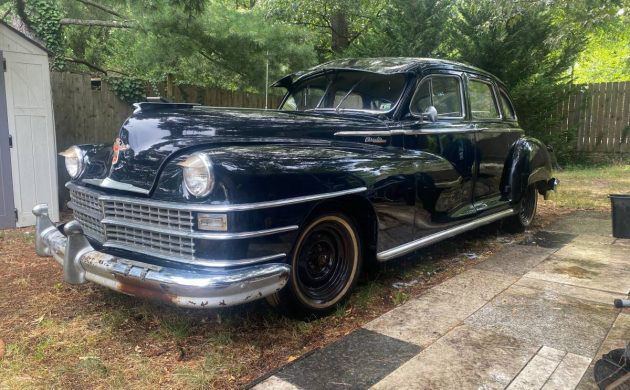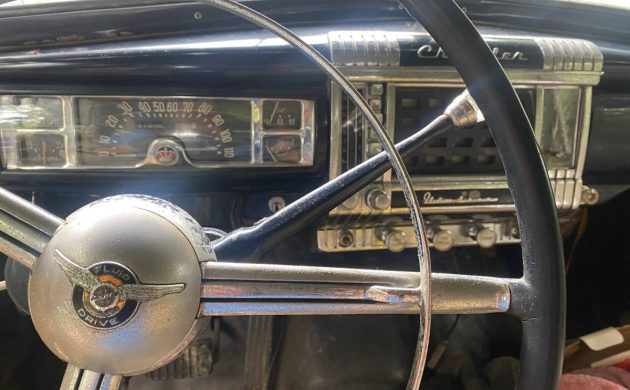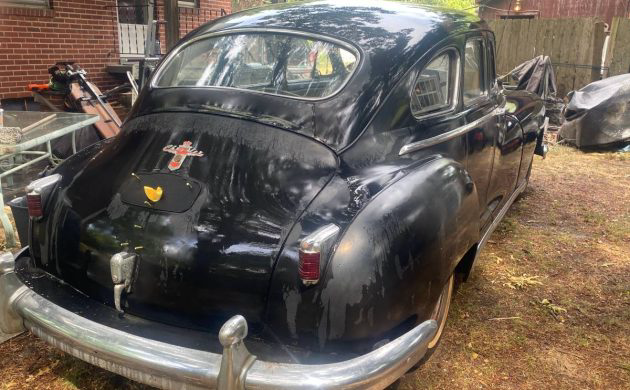Stored 35 Years: 1948 Chrysler Windsor
There’s a certain draw about a flathead Chrysler product that is dangerous to acquisitive car guys like me. Aside from the Town and Country, they’re almost universally affordable. They’re quaint. They’re durable. They’re most certainly built for a more relaxed world where the average speed on the expressway is something under 80. Regardless, stepping back into a two-lane-road kind of life is almost too relaxing a draw to ignore, which is why I always click on advertisements for Chryslers, Plymouths, Dodges, and DeSotos from the 1940s. This 1948 Windsor is for sale on Craigslist near Alexandria, Virginia, for $4,995, which sounds like a used car price if I ever saw one.
It’s a common refrain here on Barn Finds, but a lot more cars would sell if people took a few more pictures and included a little more information in their ads. Unfortunately, there are no pictures of the interior-at-large or the engine compartment of this Windsor, but the seller claims that the “engine starts and runs quiet and smooth.” There are a few pictures of the dashboard, which to be fair is one of the most impressive features of a ’40s car, with its imposing central speaker and finely crafted controls. Chrysler has always been known for its complete instrumentation, but most manufacturers supplied you with real gauges back then. Notice the “Fluid Drive” emblem on the steering wheel. The advertisement lists this Chrysler as an “automatic,” but it’s not quite that simple. Unlike contemporary fully-automatic transmissions such as the Buick Dynaflow, the Chrysler had a clutch pedal, even if the driver didn’t always have to use it.
I once mentioned on these pages that an automotive goal of mine is to drive a Fluid Drive-equipped Chrysler product, and a commenter hilariously replied that I wasn’t missing anything. Even so, I still want to give it a try, even if my patience will be tested. The Windsor’s 114-horsepower six will require a lot of pedal to keep up these days, but once you’re moving, I’m certain that inertia will win the day; you just have to time the lights or find a nice road on the outskirts of town.
You know, $4,995 doesn’t buy a lot these days, so perhaps that’s a good deal for a bank vault on wheels and a little relaxation in your drive. Thanks to Rocco B. for sending this ad our way, and let us know if you’re the one to give a Fluid Drive Chrysler a try.
Auctions Ending Soon
 2002 Subaru Impreza WRXBid Now2 days$333
2002 Subaru Impreza WRXBid Now2 days$333
 1975 Chevrolet Corvette ConvertibleBid Now2 days$4,000
1975 Chevrolet Corvette ConvertibleBid Now2 days$4,000
 1964 Ford F-100 Camper CustomBid Now2 days$2,000
1964 Ford F-100 Camper CustomBid Now2 days$2,000
 2006 Jeep Wrangler SportBid Now4 days$10,500
2006 Jeep Wrangler SportBid Now4 days$10,500
 1974 Datsun 260ZBid Now6 days$750
1974 Datsun 260ZBid Now6 days$750





Comments
I took my road test on a 46 Windsor, and no, I’m not that old the car was old.
Some 30+years ago I was looking for an old car to play with and one of the candidates was a ’51 Chrysler Saratoga club coupe with the first generation Hemi and the Fluid Drive, the owner showed me how to operate it and it was pretty simple, when my sister was of driving age Dad tried to buy a ’48 Dodge coupe with one as well but he couldn’t make the deal for it,the car in the article would probably make a good starter car for a first time car hobbiest.
I’m constantly telling people ,”I wasn’t born in 47, I am 47.”
That radio is huge. Does it have tubes in it? Curious about the Fluid drive. There’s no indicator on the steering column, does it shift sequentially?
Definitely has tubes in it ; transistor radios were probably early 60s
To answer your questions: Yes on the radio tubes.
Fluid Drive: Yes. Unique how it worked and many referred to it as “semi -automatic.” It had a torque converter but also a clutch pedal. Manually, you could shift from low range using the clutch or you could just leave it in high range and drive it like an automatic, but I found them to be very slow and sluggish to get going that way. When you elected to drive it like an automatic you would leave the column shift in high then as it starts off rolling in low you would take your foot off the gas and “clunk” it would shift into high. Not recommended to pull out in front of a train with fluid drive.
The 3 immediate post war years found fluid drive in Chrysler, Dodge, and DeSoto, but not in Plymouth.
Leland, more like a coupling than a torque converter. My 48 Chrysler has the hydraulic fluid drive, not the semiautomatic. One was an M5 and the other an M6 I believe. You really have to idle them down low to get them to shift properly.
The first photo looks almost identical to the Chrysler MISS DAISY backed over the hill. Leading her son to hire a chauffeur for her next Hudson and series of Cadillacs. What a great film showcasing these great cars and Jessica Tandy and Morgan Freeman. A classic example of overcoming bigotry with love and compassion. Unfortunately those lessons still have not been completely learned. See DRIVING MISS DAISY for a time when things SEEMED simpler but were still complicated.
Hello, RICH W!!! “Driving Miss Daisy” — one of my favourite movies of all time! Unlike films actually made in the 1940s, the characters here are not caricatures — the black members in the cast come-off as REAL people WOULD, and not as white people in the 1940s tended to see “domestic help”. And we get to see Dan Aykroyd in a comedic role that is not silly. This film is a comedy; however, it manages to be more profound than a drama in getting its points across. Except for the neighbour who says, “Get back to work”, we get to KNOW each of these people — it’s hard to accept that they are fictional, when the film is over. In the novel, upon which this movie was based, Daisy’s car in the beginning was a Packard; however, they changed to a Chrysler, because it was a “luxury” car that still was plentiful and inexpensive to buy, rather than to damage a Packard. Besides, it was quite believable that Daisy, having driven a LaSalle, WOULD be confused by Fluid Drive. SOME incongruities in this film, however, drove me nuts. As authentic as it was made to be, when Booley had just bought Daisy a new 1948 Hudson, why was he driving a 1949 Cadillac Sedanette, and not a 1948? Probably harder to find. And with the new 1955 Cadillac purchase, why was there at least one 1956 car parked outside, and a 50-star flag in the show-room? Miss Daisy’s watch was wrong — probably Jessica Tandy’s own, from the late 1940s to the early 1950s, yet well-worn — a woman of Daisy’s generation would have worn a very different style. And, on the trip to Alabama, it was amusing to see the Cadillac keep switching between a 1955 and 1956 version — and the 1956 with weak rear shocks. Having been around quite awhile before 1948, and also through 1973 when the film ends, I NOTICED these things. But younger viewers likely wouldn’t. Timeless classic movie for the ages! It packs a punch precisely because it is so gentle.
Hello Harrison W
I want to commend you on your perspicacity. When I lived in California over 30 years ago…..(wow☠️) I displayed several antique and vintage cars at various car shows. There would be scouts and agents coming through the show seeking out particular period era cars for movie shoots and scenes. They were looking for prop cars to sit parked on the streets and drivers that the cast members would drive. They would keep your vehicle for weeks into months at a time but would pay a hefty daily amount for their use.
The rate then was if memory serves me correctly $300/day and $900/day or more for drivers. The downside was your pride and joy may come back with some damage. The upside was bragging rights of your vehicle being in a movie and getting paid.
A friend had a pristine 1967 Camaro convertible that was featured in a calendar for a tool company. They had a skin and bones model posing across his car hood. After the shoot when he got in his car he noticed she had bent his hood in the center across the crease. The company offered to fix and paint the “hood only ” but he knew it wouldn’t match. There was a lengthy litigation and I don’t recall the outcome. (Note to self I need to call him to find out). I never followed through with the offers after knowing and hearing about others nightmare experiences.
Reply was meant for Harrison Reed sorry. Am I going through the change? LOL
Couldn’t you get a straight eight in these, or was that not optional on this model? I assume the six was the 230.2 cid, was it something like 251 CID or something like that, what the late 60s Power Wagons used?
The straight eight was standard in the Saratoga and New Yorker, Curt. The Windsor six was 251 cubic inches, as you said.
I’ve been bringing a 1948 Chrysler New Yorker business coupe back to running and driving condition for the last year. Rebuilt carb and fuel pump, plugs ,points, condenser, rotor. Mine has the 323 flat 8 cylinder and also has fluid drive. I’m going to be listing he=re soon on BF. Its been alot of fun to work on and glad i left it all original. It shares many of the same things as this Windsor. WTH did this guy do to the brake light on this one?
Looks like the brake light has been removed for some reason.
I had 2 of the 1941 versions of that car. Both Chrysler Royals. One tip toe shift and the second one a 3 speed stick. I used to take off in low gear up to about 15mph, then let it up to shift into second gear and then use the clutch to shift into 3rd, then let up on the gas to go into fourth. It was fine in 1955 for the PA roads. I wrecked the first one, thus the second one with the 3 speed on the tree. Both built like tanks. I got rear ended by a 48 Merc convertible in the second one. Merc was seriously wrecked. Chrysler had no visible damage. Thoe spring steel bumpers didn’t budge. His Merc went under the bumper on mine.
Aaron my educated guess regarding northern interior pictures is it’s probably thrashed from clutter litter mouse droppings and who knows what else. These old cars are mansions for rodents. But it’s remarkable that it runs. Photos are vague for rust through but it’s going to need full restoration is a given.
I’d say you’re right. I’m an animal lover but I just don’t like mice.
NYC cab drivers loved fluid drive. They would select second gear, let out the clutch, and drive all day without clutching again.
That was a big plus for cab drivers and DeSoto made quite a few cabs back in the late 40’s and early 50’s. When I was younger we used to take the bus into the city for a daytrip or a weak end. I always felt sorry for the drivers having to keep their foot on the clutch in Sunday night Manhattan traffic. I always wondered if those guys had a big left leg when they retired.
I learned how to use a clutch in my dads 48 Dodge fluid drive. My dad was a carpenter and not a car guy. To him they were just modes of transportation for work and family trips to town. That little flat 6 was very under powered for such a heavy car. In the 50’s most of the roads in our area were dirt, oil with a few being asphalt paved. My dad didn’t care that it was so slow it served his needs.
God Bless America
Back in the day, a good buddy bought a nine year old ’48 Chrysler Windsor Deluxe club coupe. It was a low mileage, one owner cream puff with the 4 speed fluid coupling transmission, R&H. The low range 1st gear would have been suitable for pulling stumps. In an era of 20 cents per gallon gasoline, fuel economy was not a concern even for high school students.
Yes, what happened to the center trunk mounted brake light on the seller’s car?
Hotrodbuilder’s description is spot on. My buddy’s Windsor Deluxe had the three humongous bumper guards front and rear. It too, was rear ended. The offending ’52 Plymouth was left with a toothless crumpled front end but, only a few scratches on the Chrysler’s bumper guards.
Considering the roads and speed limits of the 1940’s and 50’s, the ’48 Windsor Deluxe was a good long distance cruiser in its day. After an initial tune up, it was just gas and go. It served him well during his junior and senior years of high school but, was sold when joined the Air Force. He always regretted selling it.
My dad had a ’51 Chrysler Imperial with fluid drive. There was a work around for the slow clunk shift, namely a fast in and out of the clutch, and some matching moves on the go pedal. Oh, how I wished it had a 3 speed.
Hi, Frog! Thank you for the nice compliments! I am Autistic, so I tend to notice [fixate upon] details: it is something you either like about me — or, it drives you nuts. A young man in his fifties, who sort of “adopted” me as his Dad, at age four after his father abandoned him and his mother was rather indifferent towards him, accuses me affectionately of having a “bionic nose” (I notice odours he can’t detect), “bionic ears” (I hear things he can’t hear, for some reason), and a “bionic memory” — because I (let’s say) can see a movie once, and remember every word of dialogue. But AGE is affecting me in ways that are new to me. What did I come into this room to do? Where did I put my keys? Do you mind calling me? (I can’t seem to find where I set my ‘phone down). Does this happen to others also, when they get to their eighties and beyond?
Hello Harrison, I’d have to say or think that your autism is more of a gift. You are not alone with cognitive decline. Many people suffer from it half your age and even younger including myself. I think it’s important to focus on brain food for brain health. Blueberries walnuts salmon foods rich in omega 3 for example. My mother just passed away at 96 in September. Her memory was extremely sharp up until her final days. Her fathers memory was extraordinary in detail. He could recite details
such as day of the week address month year names etc from 70+ years ago. He passed away in his 90s.
Studies and research have also shown sleep apnea which causes oxygen deprivation in the brain to be a culprit as well. Then there are those who have abused their body with substances starting earlier in life who begin suffering the effects from their bad choices. We live to learn and then we learn to live.
Friend Frog: I appreciate your denominatng Autism as a gift — because, that is how I see it. If someone created a “cure” for Autism, I would decline it in my case. Besides, I already have paid the ugly “dues” — so I’ve earned the ability to love my Autism: I wouldn’t have it any other way, particularly for the oddball special abilities. But if someone else would rather not be Autistic, I can appreciate that, too. I never “abused substances” — so, that is not a part of my history. A great number of my relatives have lived deeply into their late nineties and well beyond 100 — and none have suffered cognitive decline. Heart-disease doesn’t run in my family, either. But cancer does. None of my great-grandparents had cancer, but two of my grandparents died from it, as did both of my parents. I do not recollect any of them being beset by misplaced keys, or not remembering why they had entered a given room. My older sister has no problem with any of that. Her late husband, in his mid-eighties at the time, began to lose his glasses and his keys, and to forget why he had gone into a room. Within a few years, it was clear that he was slightly impaired. He missed a stop sign and collided into another car. Nobody got hurt; however, at age 88, that was the end of his driving. He loved to go out walking; but one day, he got lost and couldn’t figure out how to get back home. After that, he was taken to a neurologist, who diagnosed him with suspected Alzheimer’s — definitely dementia. He began repeating questions, not remembering that he’d already asked the same thing earlier. He’d start to tell you something, then “lose the thread” on what he had been so urgent to convey to you. He died of cancer at age 91, still able to recognise people he knew, buy plainly cognitively impaired. So, is my newfound “forgetfulness” the start of something more serious? — only time can tell…